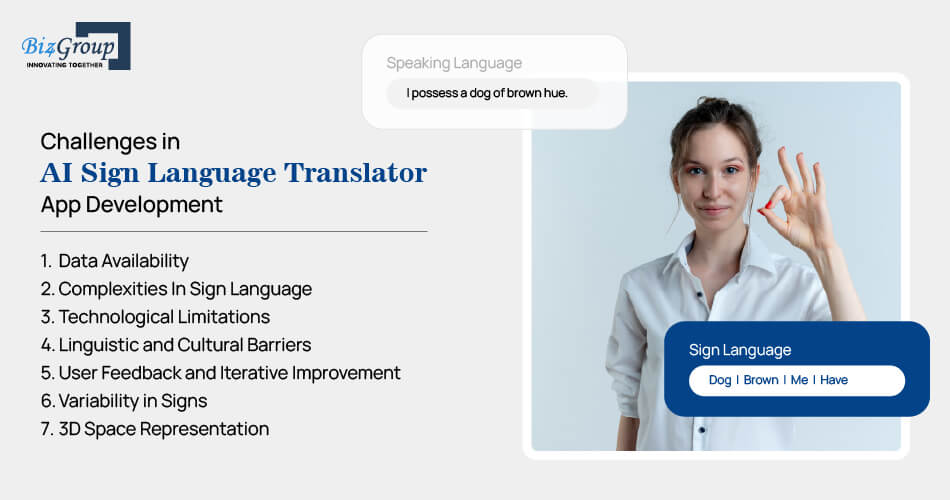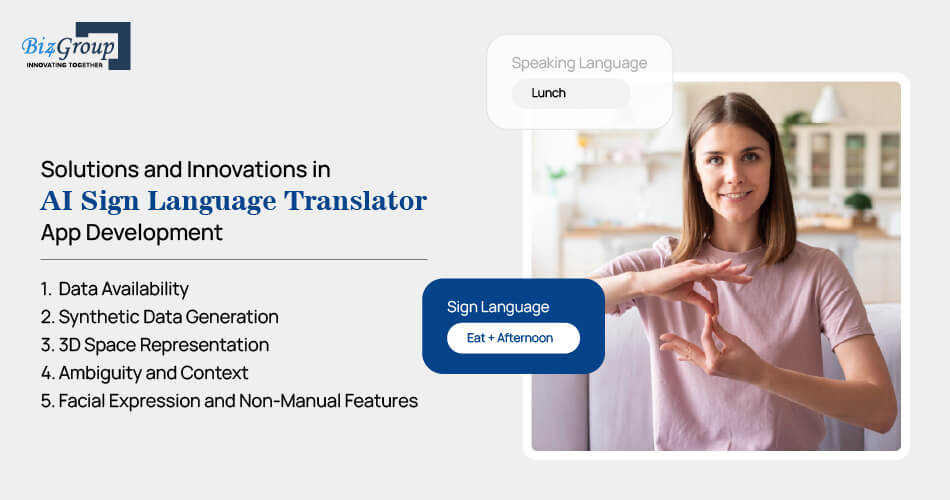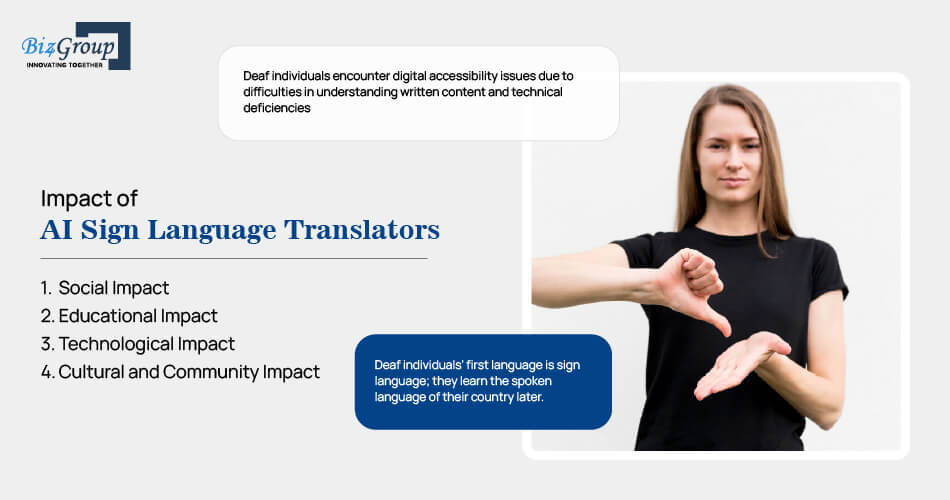Basic AI Chatbot Pricing: A simple chatbot that can answer questions about a product or service might cost around $10,000 to develop.
Read More
Communication through sign language is significant, especially for people with impaired hearing. Since artificial intelligence has improved, the creation of sign language translation applications is a fitting course of action to assist the marginalized. These applications incorporate the process of AI for the translation of signals into the vocal or written language or vice versa. However, the development of the AI sign language translator app is not without some forms of difficulties.
Biz4Group, as an AI development company, can ensure you to guide through the process of resolving challenges in AI sign language translator app development.
There are multiple challenges in AI sign language translator app development. Let’s explore them:

Compared to other forms of language data, sign language data is limited. One of the major difficulties in the development of reliable artificial intelligent systems is the need to use large and diverse data sets for training. Gathering many associated sign language data may not be easy since it entails involving sign language experts and fluent sign language users.
Since sign language is complex it is expressive by the position, shape, and movement of hands, face, and the body. This specific style of thinking is called visual-spatial in nature, which makes it difficult for AI to capture the details correctly.
Another challenge relates to technological limitations. Computer vision technology is used in multiple AI models for detecting and interpreting hand gestures and movements. However, to obtain accuracy in recognizing a gesture is challenging. Real-time processing is also important to make sure that communication is smooth and uninterrupted, which demands better algorithms and hardware.
Biz4Group, as a software development company, can help you with mobile app development services for your AI sign language translator application.
There are various sign languages used in different countries and regions. Every sign language is unique, and it has personalized variations and grammar, which makes the development of an AI sign language translator app challenging. There is also the cultural barrier to consider avoiding inaccuracy in translations. Lack of understanding of a cultural background can lead to misunderstandings.

Making sign language AI systems function properly, the specialists need to have feedback from the deaf and hard-of-hearing people constantly. Moreover, it is crucial to gather the feedback from users since this will enable the enhancement of the accuracy, usability and accessibility of the systems in subsequent iterations. Incorporation of the target community in their active participation during the developmental process is rather important though sometimes elusive.
International sign languages including ASL or BSL are unique in grammar, the words they use and the regional difference they encompass. Furthermore, for the signing individuals may stage a singularity of signing gestures in general. Due to natural variation from person to person, AI systems need to be designed in such a way that they capture the variation with high accuracy, and this adds to the challenges when developing models for training AI systems.
Sign language includes finger and hand gestures, and sign language also uses facial expressions, body posture, and movements. It is also important that the digital model allows for consistent portrayal of these dynamic movements and spatial interactions, which can be achieved through technologies such as depth sensors or a motion capture setup. Advanced technologies that can be used for data capture may be costly and hence may not be adopted widely. Furthermore, complex processing is needed when this data is fed into AI models.
Multiple solutions could be considered while building an AI sign language translator app. Let’s explore them:

Crowdsource the sign language community to gather a large and diverse database of sign languages along with annotations where possible. Engage with organizations and institutions that target either deaf consumers or deaf organizations for purposes of data collection.
Develop a convenient mobile application that will enable native signers to contribute their signing data in exchange for some incentives such as ratings or gifts to gather a vast amount of data annotated by the native signers.
To achieve the goal of developing synthetic sign language data, AI techniques need to be applied. It can employ the use of actors and use motion capture to generate many signs and phrases which may not be naturally produced. By Introducing generative adversarial networks (GANs) of the highest complexity level, and techniques for 3D modeling to create high-quality synthetic data of signs regarded as noise in real life.
By using some of the newest technologies, like depth sensors, including Microsoft Kinect, and other technical motion capture, like wearable motion sensors, to obtain accurate 3D movements and spatial relations.
Also, by creating portable, affordable and compact full body motion sensors that can be inserted into mobile phones or other portable devices so that people with sign language can record quality sign language data in their mobile phones.
Biz4Group, as a generative AI development company, can help you build a customizable chatbot for AI sign language applications.
To leverage machine learning (ML) to build context-aware models that can decipher signs based on the general flow of the conversation and apply NLP methodologies to dissect contextual hints.
This way supplement contextual information concerning objects and scenes of the surrounding environment using computer vision to improve the results of sign interpretation.
Integrate modern facial capture to track and analyze non-interactive channels including faces, expressions and head motion. By creating machine solutions to capture and understand fine movements and facial expressions in real time and integrate this data into sign language translation.
There are various impacts of AI sign language translators: social impact, economic impact, educational impact, and technological impact. Let’s know them in detail:

These translators can also be used for social interactions and help people with hearing impairments or hearing people to effectively communicate. In addition to this, real-time sign language translator applications assist in facilitating real-time translation that helps in ensuring that everyone facilitates equal utilization of services in areas like education and employment among others. Increased understanding of deaf people can result in increased social integration and the ability to function effectively in society for the disabled.
In educational systems, AI sign language translators will be very useful in filling the communication gap existing between students and their instructors. This technology helps in the instantaneous translation of lectures, instructions, and any form of interaction that would otherwise be out of reach for a deaf student.
The progress of AI translation for sign language shapes the evolution of related technologies. Computer vision, machine learning, and natural language processing are some of the advancements that are necessary to enhance the effectiveness and reliability of these translators. When developers have focused on the difficulties of translating sign language, they contribute to the development of AI. Such developments can also extend to other fields apart from sign language interpretation including automobile transport systems, health care, and robotics.
AI sign language translator app can be in the form of a chatbot that the users can interact with. Biz4Group, as a software development company, can provide you custom chatbot development services. It can help with more reliable interactions and more fruitful results.
Translators can help to make sign languages more noticeable and comprehensible to normal people and therefore gain acceptance. It might also increase the overall positive perception of deaf culture among the general populace.

The emergence and advancement of AI sign language translator apps is a positive sign in helping the deaf and hard-of-hearing population express themselves. However, it is such a process that has serious problems that must be solved. Among them, there are obstacles to collecting diverse and high-quality data for sign language due to its complexity of development. Technological constraints, language, and cultural differences, end-user uptake, and ethical issues add further challenges to the technological process.
However, there exists hope and opportunities in the form of inventions and developments despite the challenges mentioned above. Some of the principal measures to enhance AI sign language translators include crowdsourcing and collaboration with sign language communities, synthetic data creation, and utilizing advanced machine learning techniques such as transfer learning and multimodal learning.
If you want to build a sign language translator app for your business, you need to pick the right strategy. We (Biz4Group) can help you build your AI sign language translator app with our on-demand application development services.
IN YOUR BUSINESS FOR FREE
Our website require some cookies to function properly. Read our privacy policy to know more.